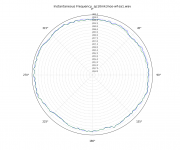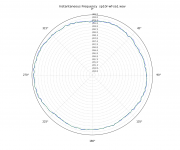Try and measure something!
Try and measure anything that correlates to perceived sound on any level above basic midfi
Digital, analogue, amps...anything
Last edited:
Digital, analogue, amps...anything
No point in spreading "The Lounge" type discussions here but in fact it is rather easy to find amplifiers considered high end with easily heard and measured distortions. Asking for correlation with perception is a difficult blend of the difference vs. preference issue.
I posted a simple .wav of a 200Hz tone frequency modulated at 2Hz. Presented with this cold without any explanation many folks would swear there is 2Hz content but there is none (this is before you realize that your computer speakers can't reproduce 2Hz). So I guess it's at least possible that FM of program material can be perceived as low frequency anomalies. This is all measurable but your preferences are your own even if you want to involve concepts like PRAT, etc.
Although I don't agree totally with analog_sa's impressions of turntable drive systems and the "best" bass, subjectively I do have a sense for where he is coming from.
That said, the measurements and analysis shown so far in this thread are original (AFAIK) and should have lasting value. It would be a pity to have that derailed via yet another objective vs. subjective argument.
May I suggest that this thread stay focused on numerical measurements and analyses, and considerations on how those tie into subjective perceptions be left for another day, and another thread?
That said, the measurements and analysis shown so far in this thread are original (AFAIK) and should have lasting value. It would be a pity to have that derailed via yet another objective vs. subjective argument.
May I suggest that this thread stay focused on numerical measurements and analyses, and considerations on how those tie into subjective perceptions be left for another day, and another thread?
Dare I mention this? Subjective observations can be objectively tested, but only by the (dreaded!) Double Blind Test, and it takes a lot of time and effort of several listeners as well as those putting on the test. This isn't even asking "which one do you think is better," just "can you hear a difference between the two?"
The cost (time, money, even emotional costs) is enough that few subjective claims ever get tested this way.
The cost (time, money, even emotional costs) is enough that few subjective claims ever get tested this way.
Although I don't agree totally with analog_sa's impressions of turntable drive systems and the "best" bass, subjectively I do have a sense for where he is coming from.
That said, the measurements and analysis shown so far in this thread are original (AFAIK) and should have lasting value. It would be a pity to have that derailed via yet another objective vs. subjective argument.
May I suggest that this thread stay focused on numerical measurements and analyses, and considerations on how those tie into subjective perceptions be left for another day, and another thread?
+1
Whatever the cause of differences in how various platters and drive systems might sound, one can fairly and reasonably say that isn't related to platter speed stability. This is because platter speed can typically be shown to be constant for practical purposes. At least for normal, healthy rigs of many and various types.
LD
LD
Last edited:
I did a rather crude experiment with 100g. weight + dummy Nylon stylus. Video was posted Here. Though being a quartz drive with no speed control knobs. the turntable overcame the massive force (100g) to maintain the speed. Now I am confused if 2 to 3 gm varying pressure will have any effect on speed stability. I think I should have looked at strobe lights before and after placing the 100g weight; and noted down the time it took to return back to normal speed. I guess the crude experiment I did only showed the torque of the motor.
Regards
Regards
At least 3 well conducted tests using polar plots say no meaningful effect on platter speed. Not been contradicted, or method flaws pointed out.Now I am confused if 2 to 3 gm varying pressure will have any effect on speed stability.
That is not to say that varying pressure cannot cause pitch variation.
Stylus-groove friction or drag changes from moment to moment, say due to natural variation in groove surface, or programme modulation induced drag from cartridge suspension. Because this drag force can only be applied along the line between stylus and arm-pivot, rather than tangentially to the groove, it causes a torque to move the headshell relative to the record. And so, by headshell motion, induces pitch changes. Large enough to be audible, and clearly measurable.
This pitch modulation does show up clearly in normal polar plots, even with a continuous tone, because of natural variations in stylus-groove friction over a rotation. One can measure it, and confirm it typically has a spectral signature that matches the cartridge-arm resonance.
But it has nothing to do with platter speed variation. It has to do with cartridge/arm stability and mechanics.
To improve it, one has to tackle cart-arm stability. After that, the elephant in the room is then stylus-groove friction, and improving that really is the search for the elixir of vinyl playback performance, IMO.
Cart-arm stability, spindle centering/warp reduction, and reduced stylus-groove friction are the 3 graces of pitch stability, in an otherwise healthy rig.
LD
Last edited:
I think I understand you LD. And thanks for explanation. So suppose we get a test record with locked in groove with varying modulation. And a special tonearm (A cheap cartridge fixed to a stiffest wand and Knife edge bearing so headshell moves only vertically) will that help in absolutely clearcut distinguishing the speed variation problems in a turntable system ?
Regards.
Regards.
I have a polar plot for an LP12, attached below.
LD
With these plots, how is the location of say 0 and 90 degrees determined?
Are these assumed locations on the platter that can't be pinpointed so as to make corrections?
This is of relevance for setting up a dynamic balance rig.
DIY motor dynamic balancing
You could make a light scratch on your test LP and line it up with a marking on your platter.With these plots, how is the location of say 0 and 90 degrees determined?
Are these assumed locations on the platter that can't be pinpointed so as to make corrections?
This is of relevance for setting up a dynamic balance rig.
DIY motor dynamic balancing
Recording and analysing the LP 4 times, each time 90 degrees shifted, you may be able to discriminate between LP eccentricity and spindle/platter misbehaviour.
Hans
OK, I'll check that thread out, thanks.With these plots, how is the location of say 0 and 90 degrees determined?
Are these assumed locations on the platter that can't be pinpointed so as to make corrections?
This is of relevance for setting up a dynamic balance rig.
DIY motor dynamic balancing
Meantime, as Hans says, you need a marker in the test file that identifies location on the record if absolute reckoning is required.
Note that convention has time moving clockwise on the polar plots, whereas absolute location on the record has opposite sense when you think about it...........
LD
Yes, I recall there was an analysis at Sterophile by John Atkinson at the same time, and they used the same files.
Linn LP Playing System Measurements | Stereophile.com
Goofballs "software radio" never became open or available though. Good however that there are interests enough to pursue and develop these measurement tools.
Since 1990 I have used the 10 g Akito arm, but changed to a light-weight 4 g arm (Moerch UP-4) 2016. Vertical resonance increased from 8 to 10,5 Hz, but I really want to go higher for the vertical direction. The DP-8 arm is on my wish-list but very expensive. I am also still hesitant to the published measurements made so far with the DP-8 (vertical resonances between 16-19 Hz).
Nevertheless, the change from 8 to 10,5 Hz decreased the warp-induced noise by 5-6 dB.
Dropbox - Tonearm mass and noise LP playback.pdf
Linn LP Playing System Measurements | Stereophile.com
Goofballs "software radio" never became open or available though. Good however that there are interests enough to pursue and develop these measurement tools.
Since 1990 I have used the 10 g Akito arm, but changed to a light-weight 4 g arm (Moerch UP-4) 2016. Vertical resonance increased from 8 to 10,5 Hz, but I really want to go higher for the vertical direction. The DP-8 arm is on my wish-list but very expensive. I am also still hesitant to the published measurements made so far with the DP-8 (vertical resonances between 16-19 Hz).
Nevertheless, the change from 8 to 10,5 Hz decreased the warp-induced noise by 5-6 dB.
Dropbox - Tonearm mass and noise LP playback.pdf
Here's an SP10MK3 that was NOS (factory sealed box) a few weeks ago, and an SP-10R. Plots are time-synced from the same record.
Dropbox - sp10mk3nos-wf-sa1.wav
Dropbox - sp10r-wf-sa1.wav
Dropbox - sp10mk3nos-wf-sa1.wav
Dropbox - sp10r-wf-sa1.wav
Attachments
Here's an SP10MK3 that was NOS (factory sealed box) a few weeks ago, and an SP-10R. Plots are time-synced from the same record.
Dropbox - sp10mk3nos-wf-sa1.wav
Dropbox - sp10r-wf-sa1.wav
Just did some speed measurements on my own revised Thorens TD124 .
Included the spectrum of the two Technics SP 10 players,
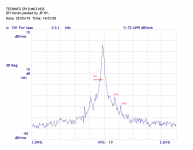
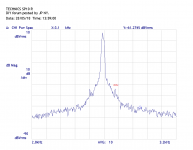
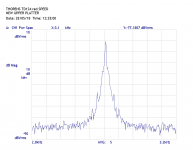
Thanks Volken. Always wanted to see measurements of Classic Vintage Turntable. How to interpret the graphs ? I presume the test track was 3K and narrower the band the more stable the speed. Right ? Original Thorens had wow and flutter measurements was 0.05%. It would be wonderfull to see Garrrads and Lencos measurements.
Regards.
Regards.
- Status
- This old topic is closed. If you want to reopen this topic, contact a moderator using the "Report Post" button.
- Home
- Source & Line
- Analogue Source
- Turntable speed stabilty



